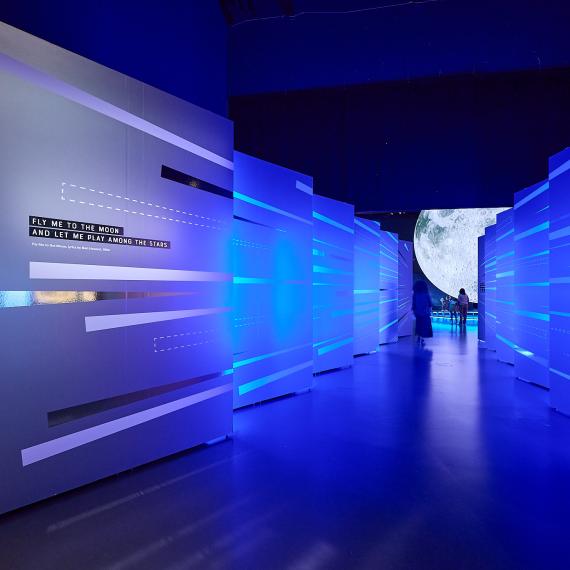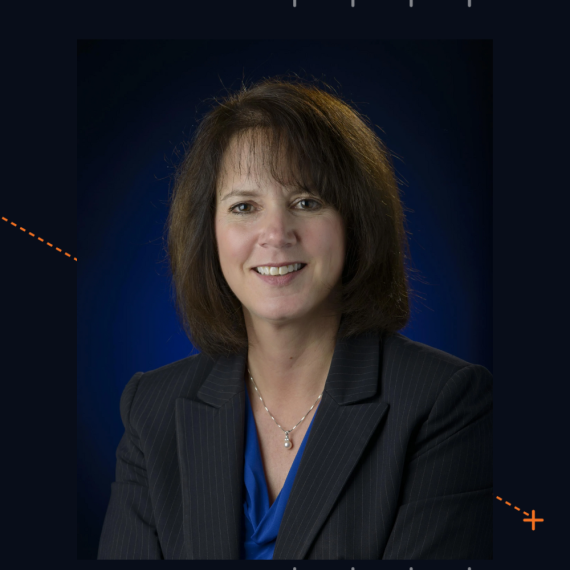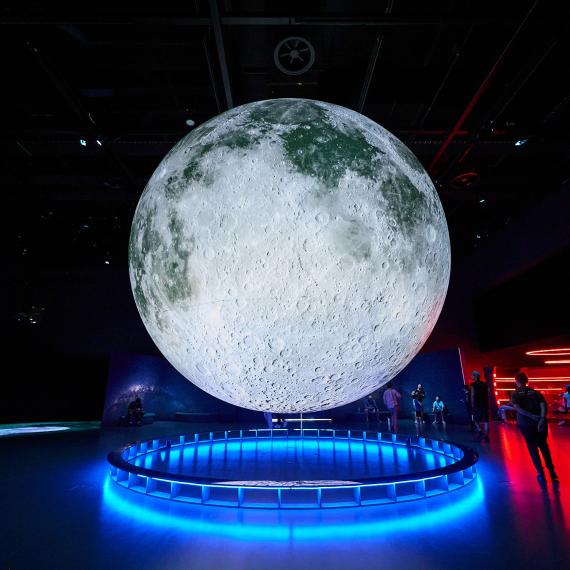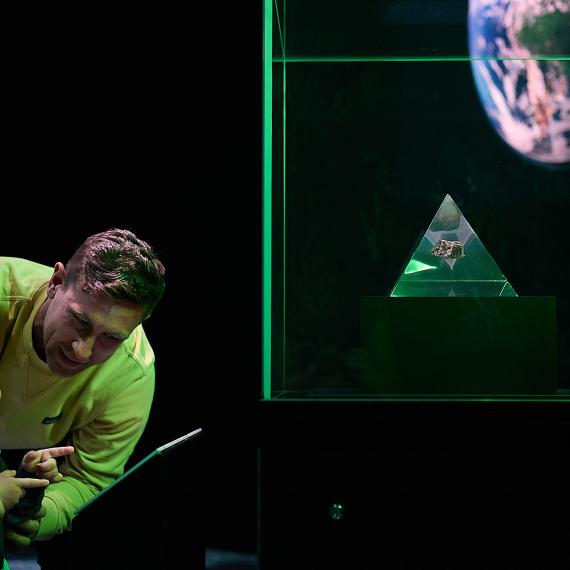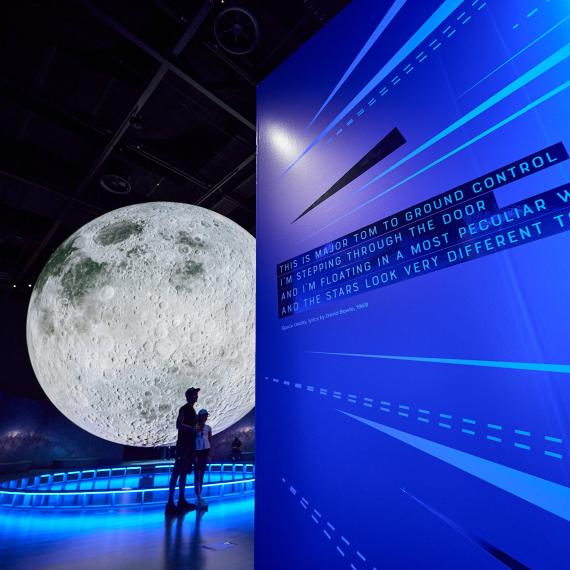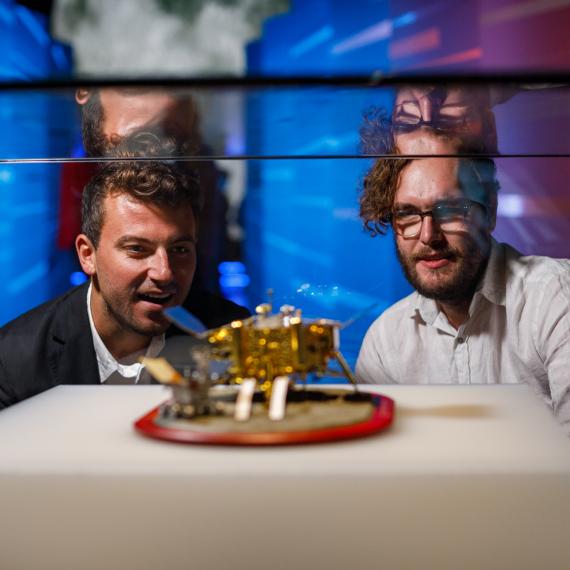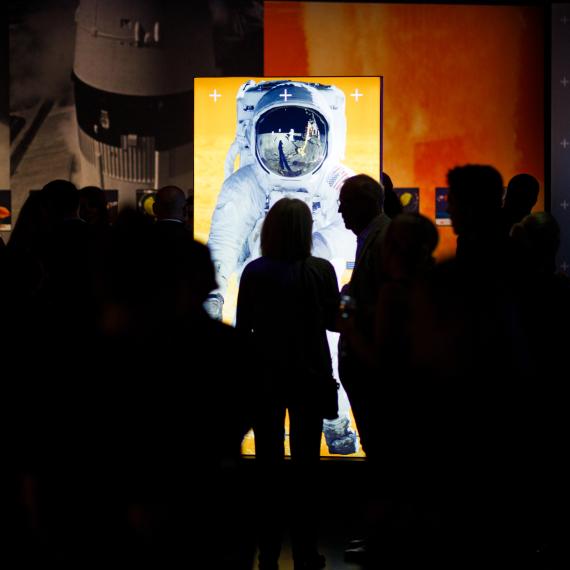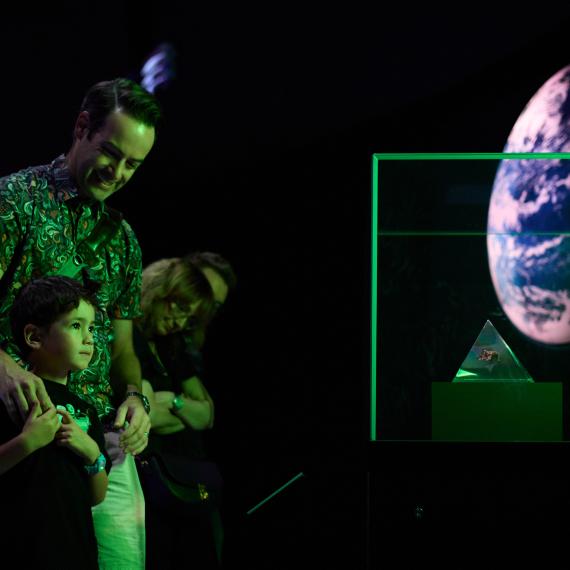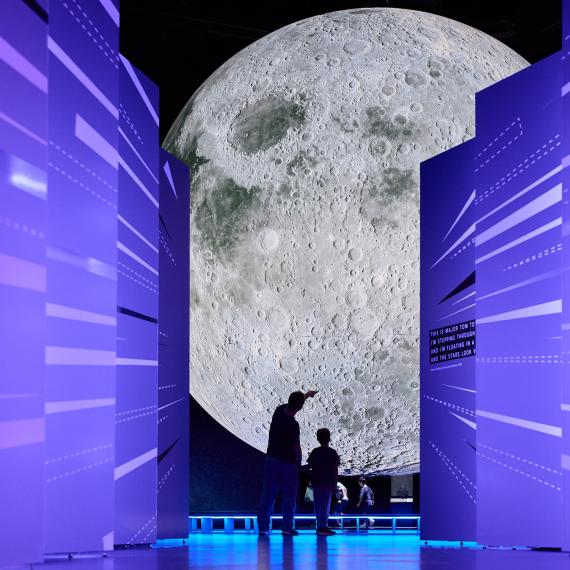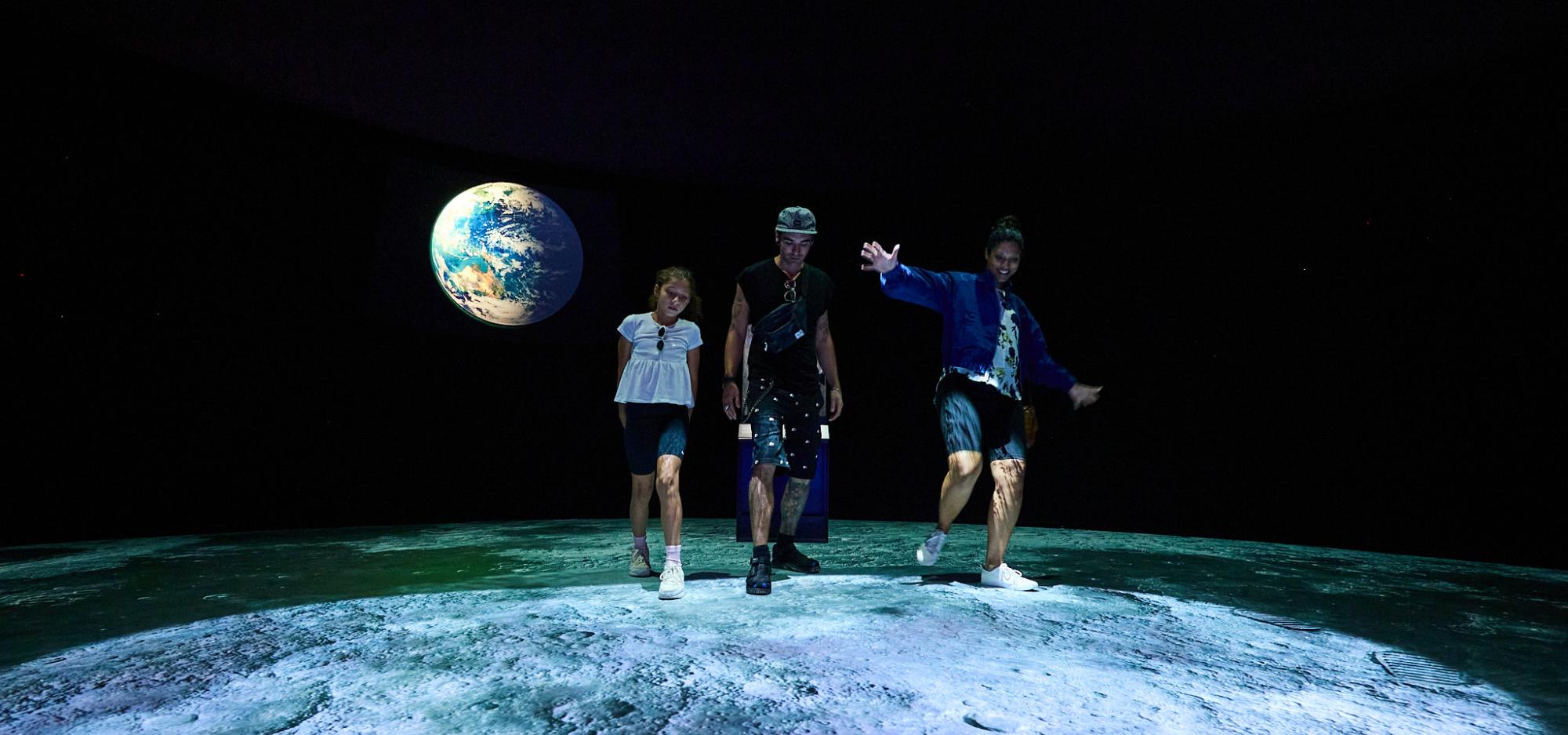
Cosmic Coincidences with Dr Robin Cook
Join Dr Robin Cook on a celestial journey exploring the mesmerising interplay of the Sun, Moon, and Earth, sparking captivating cosmic phenomena. Uncover historical significance and delve into scientific explanations of Solar and Lunar Eclipses.
This talk was recorded as a part of the Lunar Lounge series for the To The Moon exhibition.
-
Episode transcript
Intro:
You're listening to the Western Australian Museum Boola Bardip Talks Archive. The WA Museum Boola Bardip hosts a series of thought-provoking talks and conversations tackling big issues, questions, and ideas. The Talks Archive is recorded on Whadjuk Nyoongar Boodja. The Western Australian Museum acknowledges and respects the traditional owners of their ancestral lands, waters, and skies.
Event MC:
Good evening, everybody and welcome to the WA museum Boola Bardip and the Luna Lounge in “To the Moon” exhibition. So, this evening we're joined by Doctor Robert Cook, who over the next 30 to 40 minutes is going to be taking us through, Cosmic Coincidences: A guide to lunar and Solar Eclipses. Fantastic. Please make him feel welcome.
Dr Robin Cook:
Thank you. Thank you very much.
I must admit, I'm a bit confused about what kind of subset of society I have with me here today. Because obviously you're not like sports fans because you'd be at the AC Milan game tonight and you're not nerds because I just saw you all dancing earlier. So clearly, it’s not that and “Better Homes and Gardens” just finished. So, you don't have any interest in DIY projects. So, what are you? I just don't know. But I'm excited to find out. I'm excited for you to join me on this journey. I'm going to be talking about solar and lunar eclipses and how these are a cosmic coincidence of sorts. So, let's, let's get started here. as I mentioned, I'm an astrophysicist, and as well as being able to study galaxies and try to understand how they work. One of the perks of the job is that I get to travel a lot and it's probably one of my favourite parts of jobs. You know, being able to travel to other telescopes and travel to conferences and see all parts of the world is really, really great. But one of my favourite places to visit is this place, Exmouth, up north, just up the road, a casual seventeen hours. Has anyone been to Exmouth before? All right. Keep your hands up. If you were in Exmouth last year? Were you in Exmouth last year, specifically during April? I knew there'd be someone. Excellent. Okay. So, I was also in Exmouth last year during April, and I wasn't there to see the beautiful beaches and swim with the whale sharks. I wasn't there to do any of that. I was there specifically for one reason and one reason only, and that was to view the total solar eclipse of the sun, where the sun would pass behind the moon completely enshadowed by it for a brief 57 seconds, to be exact and the entire Ningaloo, Ningaloo Reef would be descended into darkness.
Right, and as far as eclipses go, this was a very, very, rare type of eclipse. Not less for the fact that there was only about three places on the Earth that could actually witness this eclipse happening. The other two of these were Timor-Leste and Indonesia and I'm not talking Bali, Kuta, Indonesia. I'm talking middle of nowhere, random island somewhere in Indonesia. So really, despite its remoteness, Exmouth was practically the prime location for viewing this solar eclipse and, you know, tens of thousands of people flocked to this tiny little coastal town, to share in this experience together. Some like myself, viewing solar eclipses for the first time. Some people maybe multiple times. Some people I spoke to had been to twenty other solar eclipses in their lifetimes so some serious, solar eclipse hunters. But, you know, there we were, all huddled together, looking up at the sky, the moon slowly crept across the sun. The surroundings became more and more like, like twilight and the temperature was dropping and then suddenly this happened. The sun completely vanished from view and behind it, this corona emerged from the behinds of it, and it was, it was this incredible sight. People were losing their mind. There were people crying next to me. I shed a tear, I'll be honest, I admit this. It was just such an overwhelming experience, and it was such a beautiful thing to see, and I think I am hooked, and I will definitely be going to see the next one whenever I can.
But to appreciate what made this eclipse so special and that, you know the reason why people came from all parts of the world just to this tiny little town to witness 57 seconds of darkness. To appreciate this, we really need to understand a little bit more about how eclipses work. All right, and let me start by saying this, all the celestial objects in our solar system, the planets, the stars, the asteroids, everything is illuminated by our sun, not the stars, but the planets and asteroids and moons are certainly illuminated by our sun, and behind each planet, behind each moon is a shadow that falls out. Something that extends out to infinity, away from the sun, right, and it's these shadows that allow us to witness solar eclipses, right. When we talk about eclipses, we're referring to actually a broader concept known as a Syzygy. This is a really technical term for the alignment between three objects. I just wanted an excuse to put this word up. Its, six letter word with no vowels and three y’s in it. What other word in the English dictionary do you know that does that? That's an incredible word. But it is really just the alignment of three objects, right? And an eclipse is exactly the alignment of the sun, the moon, and the Earth. Right, and the moon, itself orbits around the sun, ah, around the Earth and around the sun, but it does so around the Earth every 29.5 days.
Right, which is kind of roughly a month. By the way, this is where we get the word month. It's moon-th but shortened down to month and so this is happening every 29.5 days. So then why is it then that we don't see a solar eclipse every single month, right? Now, if the, the moon itself orbited in the plane of the ecliptic, this is the plane in which the Earth is always moving, then yes, every single month on a new moon, the moon would eclipse the sun completely, right? But as it happens, the orbit of the, the moon is actually inclined ever so slightly by five degrees, which doesn't sound like much, but it is enough that most of the time the shadow of the moon actually misses the Earth entirely, right? And in order for you to get an eclipse right, you required exactly this. The moon must pass through the ecliptic plane at the same time as it’s having a syzygy, okay? this alignment of three objects, which is quite rare. There are only two opportunities in a year for this to happen, right? And if the moon just doesn't happen to be in the right place at the right time, you don't get a solar eclipse. This is why solar eclipses are so rare, or eclipses in general I should say, lunar and solar eclipses, okay.
So, there's two types of eclipses and this depends on which side of the earth the moon is situated. You know, if you have, a lunar eclipse, this occurs when the moon falls in the shadow of the Earth, whereas a solar eclipse is occurring when the moon, blocks out the light from the sun and casts a shadow onto the Earth.
Now, by definit… by definition, this means that a lunar eclipse is always a full moon. It's on the other side of the the Earth. It's completely, being lit up by the sun. And on the other hand, a solar eclipse always occurs at a new moon, right? By definition. But crucially, the big difference between these two kinds of eclipse is that for lunar eclipses, everyone on the nighttime side of the planet gets to see it all at once, right?
Because the shadow is so large that the entire moon is covered by, by the shadow of the Earth. This is not the case for solar eclipses. The moon is much smaller, and so the shadow that it, you know, puts onto the Earth itself is significantly smaller and only targets a very specific line or trajectory across the planet.
So only specific places on the planet get to see it, for any given solar eclipse. Right. So, this is the big difference between these two eclipses.
So first, let me talk about lunar eclipses because, frankly, they're the least exciting of the two of them. but understanding them sort of gets us a little bit primed for the cool stuff, which is the solar eclipses. So, here's an example of a lunar eclipse. This is just, you know, time lapse, let's say of, of a, of a lunar eclipse occurring, going from the full moon on the right to total, total lunar eclipse on the left. And to understand this, we need to understand that there's two kinds of shadows that are produced, by the sun and the earth, right. The first is called the umbra and this is sort of the main shadow, the primary shadow that, the Earth casts and being within this shadow, you're in complete darkness, frankly, right, you're completely in dark, this is the nighttime. By definition, being behind the shadow means, and you're not getting any light from the sun. But there's also such thing as the penumbra, which is your view of the sun is slightly obscured by, in this case, the Earth. But there's still some light getting to you by some other means of the sun. Right? So, part of the sun is being, let's say, blocked out by, by the object, but you're still able to see the sun. And this is two different kinds of shadow that are cast upon, you know, the space behind the earth and you can see what happens as the moon passes into the penumbra. You get what's known as a penumbral eclipse, okay? and this really is not noticeable to the human eye. The drop in brightness that you, you notice in a penumbral eclipse is basically nothing. You would just have to know that it's happening for you to, to see anything. But as you move towards the umbra, this is the main shadow of the earth, you start to see that shadow creeping across the face of the moon as this sort of red blanket that that sweeps across.
Okay. And then finally, as the, the moon enters the entire, shadow of the Earth, you get what's known as the total lunar eclipse. And you might be wondering, well, if it's in the shadow of the Earth and this is like nighttime, why can we even see the moon at all? And for that matter, why is it even red? Why is it this reddish hue? Right? And the answer to that is actually kind of interesting. It has to do with, this thing called Rayleigh scattering. This is where you have light coming from the sun, it's got all wavelengths of light, it's white light and some of that light is being scattered, but it's preferentially the blue light, the violet light, the green light, that's the light that's being scattered away and by the way, that's why the sky looks blue, because that blue light is being scattered into the, into the atmosphere. So, what's left behind are the yellows, the oranges and the reds and that's what light, that's the light that's in passing through the atmosphere and making its way to the sun [he meant to say moon], giving it that red hue. It's the same effect that you see during sunrise or sunset, right? As that sun's getting closer and closer to the horizon, it's passing through far more atmosphere, more and more of that blue light’s being scattered away. That's why you can actually have a look at it and not burn your eyes because all that, you know, harsh blue and green light as it's been deflected away. You're only left with that red light that you're seeing there. It's the same effect. this you're just seeing being projected onto the moon rather than into your eyes. Let's say.
Okay, now we get to the good stuff. The solar eclipses, okay? So, so lunar eclipses, they, they happen quite frequently because the Earth's shadow is quite large. So, the moon tends to fall within the Earth's shadow quite frequently. But most of the time, people don't realize. For one, they happen late at night so most people are asleep, and they're sort of underwhelming. If you're not looking up, you wouldn't even notice. Right? So solar eclipses, on the other hand, are unmistakable. You can't ignore this if you happen to be in the path of a solar eclipse.
But first, I want to talk a little bit about this cosmic coincidence that allows us here on Earth to actually see eclipses in the first place. Okay, so imagine this. This is the three planets, well the planet, the moon and the sun seen from space, and on the bottom the same view that you would see from the earth.
Now, of course, this is not the scale. We know that the sun is many times bigger than the, than the moon. In fact, it's, you know, compared to the moon's p 3.5 thousand kilometres, the sun is something like 1.4 million kilometres wide. It's about 400 times larger in diameter than the moon itself. Now, of course, the sun is also a lot further away than the moon. In fact, it just so happens to be about 400 times further away. So, whilst the sun is 400 times larger in size, it also coincidentally happens to be about 400 times further away. So, to us here on earth, they look to be about the same size on the sky, right? And it's for this reason that the two can overlap with one another, and we can get these beautiful solar eclipses.
Now, this is not a given. There's no reason why this should be the case. In fact, you can go and look at, other planets in our solar system, look at their moon systems, and see where this is possible. Mercury and Venus that I have moons don't have any moons. You can't have eclipses. So, they're out of the equation. But Mars is our next planet up that has a moon. In fact, it has two moons, Phobos and Deimos. But these are tiny. These are tiny moons. They're definitely not big enough to completely block out the light from the sun. You can move further out to some of the bigger planets, Jupiter, and Saturn. Jupiter has 95 moons, Saturn just 146, so quite a lot of moons. Most of them are not very big. Most of them are sort of the size of Phobos and Deimos, but some of them are big in size. In fact, some of them rival the size of Mercury as the planet. But these are moons, moons around other planets, Jupiter, and Saturn. But the problem is, with these gas giants, there's no surface on these, these planets to stand on. There's no way you can stand on the surface of Jupiter, look out towards its moons and have it an eclipse occur. Right? It's, it's just not possible to stand on this. There's a slight exception with Saturn in that you can be standing on one of its moons, Enceladus, looking out to the sun and the moon, Titan can block your view very close to being a complete, total solar eclipse, but ever so slightly just too small, and it doesn't quite meet the criteria. and the other thing is, these are moons that are orbiting around another planet. It's just not a consistent and repetitive cycle like we have here on the Earth and the moon system. And there is one more, which is Pluto. But Pluto’s not a planet, so we can just ignore that. I mean, raise your hands if you still think Pluto should be a planet. All right, security, if you just roll up everyone with their hands. I have, er, this is. Just get over it. It's been like, 20 years, you know?
Audience:
[laughter]
Dr Robin Cook:
Move on. There's bigger, bigger things to worry about. You can talk to me later about why Pluto is not a planet. But that's not the topic for today. Okay, so I said that the sun and the moon, ah, they look almost the same in the sky, and it is almost. But there's a there's a slight nuance here, right? Because the Earth's orbit around the sun. It's not a perfect circle, right? It's, it's sort of like a squished sort of circle, an oval, a football field, if you will. But this has been exaggerated for, for effect here. But, you know, the point is that at some points in the orbit, the Earth is further away, and in some points it's closer to the sun, right? And we call this aphelion and perihelion the point of furthest and closest approach to the sun. This is really important because what this means is that the size of the sun actually changes depending on where the Earth is in its orbit. Now, it's a very subtle effect, and you probably can't even see it from the back of the crowd there, but it is an effect that changes the size of, of the sun and what's more, the moon itself also sits on an elliptical orbit around the Earth. It has its own perigee and apogee, causing it to get larger and smaller throughout the year and throughout the month. Okay, so what's interesting about this is you can get different kinds of eclipse depending on what combination of perigee and apogee, perihelion and aphelion you have gives you completely different, solar eclipses or lunar eclipses from the perspective of Earth.
And let me just talk about those four different types of solar eclipses. The first is the first of which is what's known as a partial solar eclipse. And this is just where the moon itself hasn't quite aligned completely with the centre of the sun. And so, it's only partly blocking out, the light from the sun. Now, these are really underwhelming, I must say. If you've ever witnessed a partial solar eclipse, you probably wouldn't notice anything different, right? Unless it's getting close to 90% coverage, there is not really a noticeable change in the brightness in your surroundings. You might notice a few things three shadows changing, but partial solar eclipse is pretty lame. Of course, the most spectacular types of eclipses are these total solar eclipses, and this occurs where the sun is perfectly aligned with the with the with the moon in terms of the centres and the moon is actually large enough that it can fill the entire disk of the sun blocking out all of the light cascading into darkness, and all the beautiful stuff with the corona that you see during solar, total solar eclipses. There's a third type, which is known as an annular solar eclipse. This is where the moon is either, at a further point in its orbit so it looks smaller or vice versa. The sun is actually closer to the Earth. It appears larger. Either way, the moon isn't large enough in the sky to completely block out the light from the sun, right? These are still beautiful in their own regard, in the sense that you get this nice ring effect, and this is called an annulus and therefore you get this name annular solar eclipse. But then nowhere near as spectacular as the total solar eclipses. But then there's a fourth type, right? And this is a bit of an interesting case in the sense that it's a combination of both the total solar eclipse and the annular solar eclipse, in that in part of the time that this moon was eclipsing the sun, it wasn't large enough to block out the sun. And then later on down the trajectory of the eclipse, it is larger, it's visually larger in the sky, and it blocks out the sun completely creating what's otherwise a total solar eclipse. So, it's a hybrid mode between the annular and the total solar, solar eclipses. And by the way, these are incredibly rare. They happen only about 3% of the time. These hybrid solar eclipses, in fact, in this century alone, they'll only be seven, basically, and by the way, the Exmouth solar eclipse last year was one of these hybrid solar eclipses and this is what got people so excited and the reason this happens is fascinating, right? You have to imagine for a second, we'll do this exercise. Imagine the Earth as a sphere. You sort of have to ignore the flat earthers who got it all figured out, and you know, it's a disc. But for the for this exercise, we'll assume that the Earth is a sphere for points on the sphere that are closer to the sides, they're actually further away from the moon. So, the moon, as we know, would look smaller, whereas as the moon progresses or the shadow of the moon progresses to that, let's say the tipping point of the sphere, the moon is actually gotten close to you. Well, actually, you've gotten closer to the moon because you're at the highest point of the Earth compared to the moon. So, the moon appears larger and actually fills the size required to block out the sun. And so, it's both at one point in its trajectory, an annular solar eclipse and later on becomes a total and again will become an annular towards the end. And luckily enough, in Exmouth it was a total solar eclipse at the time, which is very, very nice, of course, but by definition, because it's on the cusp of being between annular and total, it's kind of means it was very short.
It was only 57 seconds, as I mentioned, but some solar eclipses can last for much longer than this. In fact, the, the maximum that a solar eclipse can occur is about 7.5 minutes long. And probably anyone who's experienced a 7.5 minute long, solar eclipse will tell you this. Probably the longest 7.5 minutes they've ever experienced with even that 57 seconds that I experienced was, was, time bending. You know, it felt like I was there for many, many minutes.
So, it's worth pointing out that every location on Earth has, at some point in the last 5000 years, experienced a total solar eclipse and we know this because we can forward predict all upcoming solar eclipses, and we can also retro date, or previous solar eclipses that have ever occurred. But interestingly, someone living in the northern hemisphere is actually about twice as likely, maybe a little bit less than twice as likely to experience a solar eclipse than our folks in the South, which is a bit of a bummer and it's not just because there's more land mass up there. It's actually this, you know, it's, it's complicated answers as to why, but it's to do with the fact that the northern hemisphere, while it experiences its summer, as in when it's tilted close to the sun. It happens to also be further away from the sun. So, the sun appears smaller on the sky for the, for the northern hemisphere during summer and what this means is it's more likely to get eclipsed by the, by the moon because it is smaller and also, it's summer for them. So, there's more daylight, there's more opportunities for this to happen. So, this combined effect actually means that the northern hemisphere gets about twice as many solar eclipses at us. But, you know, there are other things to be jealous about.
So let me just talk a little bit about what happens during these solar eclipses. In fact, what happens at the very last few minutes or even seconds before the sun passes behind the moon itself, right? So, the very last bits of light that make their way along the edge of the moon are a single point of light, right? And what you get is this diamond ring effect, where there is a halo around the moon itself from, you know, scattered light around the sun, but you get this last final burst of brightness that comes from the very last inklings of light that make their way around the sun and this creates this pseudo-diamond ring looking at affect. And it's after this point that people often take that off of their, you know, safety viewing glasses. Because at this point, there's no direct sunlight that's making its way to, to your eyes and so it's, you know, technically safe to look at the sun. But there are a few little trickles of light that do make their way through and they're making their way through the craters that pock the moon's surface. There's actually depressions in the edge of the moon's surface that allow few little specks of light to get through the crust of the of the moon's surface and this, you can see, is little beads that kind of pockmark their way around the moon. It's quite impressive to see. You also get these prominences that occur, these are these large filaments of hot plasma that are shooting out from the sun, along its magnetic field lines. They form on like timescales of about a day, and they last for weeks and months. But these, these prominences, they can become what's known as coronal mass ejections. Right. This is where, you know, a big sputter of, of charged particles escapes from the sun. And if we're lucky or unlucky, it depends who you ask, one of those cosmic, coronal mass ejections makes its way to the Earth.
It'll interact with the magnetic field of our Earth, and we get these Aurora, the aurora borealis and the aurora australis. Which I hope many of you got a chance to see in the last few weeks or so. That was due to these prominences, these, these cosmic coronal mass ejections. Um, and then finally, once all of the light has passed behind the moon, you get these beautiful flaring tendrils that extend out from the sun itself. This is the solar corona. It's this, incredibly hot chromosphere, extending millions of times or millions of kilometres into space with temperatures that are in excess of a million degrees Kelvin, which in Celsius is also about a million degrees.
So, one last thing that I want to point out, and you'll be forgiven for missing this, but in the lower left-hand corner there, you can actually see the planet Mercury, which doesn't seem like a big deal maybe to you. To me, that's a huge deal. Like, as an astronomer, I've never seen Mercury before, right? Because Mercury is the closest planet to the sun, and I don't know if you've ever tried to look at something close to the sun. It really hurts, don't do it, I highly recommend not doing this and, you know, because Mercury is always following the sun, it's always following daytime. So, you know, astronomy is not really that good at daytime. So basically, what I'm saying is it's near impossible to see Mercury with this flaming bowl of plasma in its way. So, the only time it's really possible to see mercury, if you're lucky enough, and it happens to be on the right size side, is when the moon gets in the way, blocks all the light from the sun, and there it popped down. I was so excited to see this. There was all these people getting excited about prominences and Baily’s beads, and I was like, That's Mercury, and it's like ticked off my box of planets that I can see with the naked eye. So that's really exciting, maybe you don't get so excited, but I do. So that's what happens in space.
But I want to talk to you a little bit about what happens here on the Earth when you have a solar eclipse. Here's a frame-by-frame satellite image of the shadow of the moon as it passes, you know, over, in this case, North America. This was about a month ago. There was a total solar eclipse that lasted many minutes, went from Mexico up to Canada, went through many major states of the US. It was, pretty spectacular, and you see this shadow racing across the planet. In fact, these shadows move incredibly fast. It kind of depends on the type of solar eclipse and where it's located, but it can go as fast as 8000km an hour, which is like the width of Australia and back in, in and out. So really, really quickly, and what's interesting is that when you're in that shadow, you really do start to feel the temperature drop, right? and by as much as ten degrees of a drop, you can experience. The winds also by construction start to change, because now you've got a cold part of the earth and a warm part, and all the warm stuff wants to go to the cold stuff. So, you have these winds kind of coming in behind you. These breezes start to pick up. Something it's kind of interesting. You get a 360-degree sunset because of course the horizon is further than the extent of the shadow. So, the horizon is still sort of being illuminated by the sun, whereas above you is completely dark, or at least a sort of like a dark twilight feeling. So, you get all the way around you 360 degrees, this effect of, of a sunset or sunrise. Something that caught me by surprise, is the shadows on the ground. They start to form these little crescent shapes. And this is actually a projection of the moon passing in front of the sun, you know, being, you know, reimagined onto the ground as it passes through tree leaves or any kind of small slip which it doesn't seem obvious as to why this is. But, you know, normally when we had light coming from the sun, it's coming from all parts of the sun, so it all kind of gets blurred out and focused, defocused. But here, when you get it from a thin sliver, you see it re projected onto the ground and it’s really kind of trippy to look at it and say.
And of course, animals, they start freaking out. Because, you know, as an animal your whole life the, the, the, the sun has risen in the morning like clockwork. It's set in the, in the, in the evening. So, for it to just disappear in the middle of the day, would obviously be very distressing for most animals. Birds start to start flying away, they start singing. There's been, reports of kangaroos starting to move, you know, around because kangaroos, they're crepuscular. They move through the dawn in the dusk only really. Other days, other times of the day there's lazing about. But during solar eclipses, they'll start to get up and, you know, they start moving about. There's been records of Galapagos turtles, which during the solar eclipses started to huddle together and started mating for some reason and then looking at the solar eclipse. So, there's this, and some animals don't care. Like bears, apparently, they just don’t give a shit. They’re just, okay, another day, happy with the sun just disappearing from, from above us. But, you know, you can imagine as an animal that this would be quite distressing and quite, you know, concerning if you're your sun, your life source just starts to disappear.
But, you know, this also got, ancient civilizations kind of freaked out as well, right? and you might be thinking to yourself, well, isn't it obvious? Like, if you just look up at the sun is its sort of being eclipse. You just look up and you can see that the moon is obviously passing in front of it. Well, it's not actually that easy because as I mentioned before, total solar eclipses only ever occur on a new moon and actually, by definition, the point at which the two overlap is the tipping point of the new moon to the old moon. Right? And, you know, it basically means that you can't see the moon. It's invisible for all intents and purposes and on the morning and the afternoon of that eclipse last year, I couldn't spot the moon. I just had to put faith in the astronomers that they'd done all the calculations, and it was going to, you know, overlap because you could not see the moon. So, you know, to any ancient civilization, it's as though the sun really just drops out of the sky, completely fades away with no warning whatsoever, right? These aren't really predictable things and the earliest verifiable eclipse that we have, we have texts from, thousands and thousands of years ago, Chinese text, Arabic text. But the first one we have where we had a date associated with it comes from this, sort of clay tablet out of this ancient city of Ugarit. This is now modern-day Syria, and we have two possible dates. It's either the 3rd of May 1375 BC or the 5th of March 1223 BCE. Now, how can I be so specific, yet so unsure at the same time? These two dates are like 150 years apart and yet, we think it's one of the two of them. It's because nowadays we actually know exactly where every solar eclipse will ever occur on the Earth and in the past, where, ah, where and when every other solar eclipses ever occurred. So, we can go both forward in time and backward in time. But that's not an easy feat. And it took a long time for this to happen. Right? Took centuries to get to the point, where we went from observing solar eclipses to understanding sort of roughly how they work, some 600 years later, pass these records. You have the Babylonians, they start paying, really close attention to these lunar eclipses. This is not the solar eclipse, but the lunar eclipses, of course this was very ominous to them. They feared this had, you know, doomsday effects for their king. Nothing like a little bit of fear to get the scientific juices going, I think. But they were taking note of when lunar eclipses were occurring, right? And remember, with lunar eclipses, everyone on the planet that's facing the moon can see a lunar eclipse.
So, you can see pretty much half of all the lunar eclipses that occur. And this data, you know, gave the ancient Babylonian astronomers enough. you know, points to start to realize that there was some pattern going on where the lunar eclipses would repeat themselves every 18 years, 11 days, and eight hours, right. On repetition, this is what we call the “Saros” now. And in fact, what's interesting about this Saros is that while solar eclipses, you know, most people only see 1 or 2 in their life perhaps, they tend to also follow the Saros cycle. So even though we weren't able to observe, solar eclipses frequently back in the day from any one given location, if you look at all records of solar eclipses that have ever occurred, they also follow the same pattern that lunar eclipses follow, okay? And that's really important because, for example, if you take the 1937 solar eclipse that happened here and you, you kind of move 18 years, 11 days and 8 hours into the future, you will find an almost identical looking solar eclipse occur almost at the same location, except that extra eight hours, right, means that the Earth is rotated by a third, right?
Because there's 24 hours in the day, 8, 16, 24, 8 hours have passed and so that same solar eclipse, that the same pattern will appear a third of the way around the planet, 120 degrees, okay, westward of the original one. And then another cycle you will see again the same pattern show up, right? And this on repeat every 18 years, 11 days, and 8 hours, you will see the same solar eclipse patterns, right? and there's over 40 sets of these Saros cycles and are all overlapping and interwoven and all in different, ah, different directions and thicknesses and, and features.
But I’ve got to say this, that here in Australia, I mean, we are a continent, so we've got a lot of landmass to work with. But we’re actually quite lucky as far as solar eclipses are in the upcoming, say 15 years. Now you see here this is just a set of, next solar eclipses occurring in Australia in the next 15 or so years. You can see on the left is that Exmouth solar eclipse that happened. You'll notice it's a very thin line. And the thickness of the line here actually tells you a lot about the, the duration of the eclipse that you're experiencing. So, remember I said this was a hybrid solar eclipse that was very much on the cusp of being halfway between an annular and a total and a total. So, it was a very short duration, only 57 seconds. But these other lines that you see here, these are the trajectories. Some of them are about five minutes. Six minutes. I think one of them is even in fact seven minutes.
The one I want to point out is 22nd of July 2028. I hope everyone in this room is still alive by then. This is an excellent opportunity to see a solar eclipse, right? Look at this trajectory. It goes all the way up from the northern parts of Western Australia, through the Northern Territory, through Queensland into South Australia, just for a second, back into Queensland, through New South Wales, directly through Sydney, the city and off to New Zealand through to Queenstown. So, an incredible plethora of places to go. Look, I don't, do much travel to Sydney, but I assume Sydney in July is probably a good time to look at clouds rather than solar eclipses. So perhaps try somewhere a bit more up north. But the other one to look out for is this 25th of November 2030, right? This is towards the bottom, moving up through the Great Australian Bight or thereabouts, and into Brisbane. So, these occur in any given location, so say you don't travel at all, say you just exist in your one city for the rest of your life.
You would on average see a solar eclipse every 350 years, in fact, sometimes even more in the in the Northern hemisphere, right? So, they’re really once in a, once in many lifetime opportunities, right, these solar eclipses, right. But I hope I've convinced you at least that these solar eclipses are at least spectacular and awe inspiring and, and I hope that you'll try to see one for yourselves, maybe one of these two upcoming ones.
But I kind of want to impress upon you not just their beauty, but their importance in science as well, because they've had a real impact as far as scientific discoveries go. So, you know, these solar eclipses, they're, they're intriguing, they're auspicious, they're fascinating to ancient civilizations. So, we have many, many, many records of these solar eclipses having occurred throughout the centuries. And so, for, for example, in particular, there's this, Babylonian tablet that was uncovered in modern day Iraq from scholars who, you know, described this solar eclipse as having happened in April, of 136 BCE. Okay, so good, we go and look at our models, we're going back to 136 BCE and what we notice, not myself personally, but astronomers noticed that our predictions for where this eclipse should have been was more like, you know, northern Africa through to Central Europe and out into Russia, not through now, modern day Iraq. So, what's going on here? Something's wrong. But what astronomers started to realize is that the further back in time, the further the records were, the more off our predictions were getting. We were getting more and more incorrect from those recorded locations that these sightings had been. And so effectively, what this was telling us is that the Earth is slowing down, right, and we suspected this for a while. We've, we've known that the Earth is slowing down. This is probably due to the moon's gravitational pull. The same pull that creates the tides on Earth also has this tugging effect that is likely slowing down the, the Earth's rotation. And, you know, just by looking at the difference between the records and where we expected the eclipse to be, we've discovered that the Earth is slowing down at a rate of 1.8 milliseconds per century. So, it's not very fast. But nonetheless, this is so cool that you can just look at records of old eclipses and compare them to the models and just measure the rate of slowdown of the Earth, something you could never do on the human timescale of 100 years, just not possible. It's such a small amount, so minute, that you need, you know, thousands of years of baseline to even hope to measure. So that's pretty exciting.
But by large, by and large, the greatest discovery that eclipses have contributed to science is the confirmation of Einstein's theory of general relativity. I know it's getting kind of late, so I won't go too much into, you know, Einstein's theory of general relativity. But the needless to say, in 1915, Einstein proposed this idea that completely reshaped the way we think about matter, about gravity, about how the universe is geometry looks, he basically had this concept that objects of mass, whether it be the sun, the earth, you and I, in this room, we distort spacetime around us. We create this perturbation in space. You can picture sort of a rubber sheet across a table and putting a bowling ball, and that sheet would depress that sheet, that space being curved and objects that you put in that space want to travel towards that, that depression. Right, and this is how he looked at the universe and he, you know, famously came up with this idea that says that matter tells space how to curve and space tells matter how to move.
This kind of interrelationship between mass and gravity and the geometry of the universe. But these are some pretty crazy ideas, certainly far out of left field. And, you know, in opposition to a lot of the ideas that Einstein, ah, that Isaac Newton had put forward that were very successful in describing gravity for hundreds and hundreds of years prior. This required some extraordinary proof to, to explain.
So, you know, the problem is it's a really subtle effect, very, very subtle and it requires, you know, very minute differences to notice. You need an object of a lot of mass and the only thing we have of that much mass nearby is, of course, our sun. But again, observing the sun, incredibly bright, hard to observe with telescopes.
So, what do you do? You need to block it out. And we have something to block it out with. Of course, we've got total solar eclipses. So, in 1919, just some four years later, a group of astronomers went on an expedition to observe a total solar eclipse and go looking for stars in the distance behind the sun and trying to notice bending of the light.
You know, you expect the sun or the star to be in a certain position, and if you observe it to be slightly disordered one way or the other, you know it's because it's passing by the gravitational pull of the of the sun and it's bending that light. This is not something that Einstein predicted, er, that Isaac Newton predicted. This is something that Einstein completely came up with, okay, and this is what happened. They went out to the solar eclipse, and they observed stars in the distance, being perturbed away from their original distances by the exact amount predicted by Einstein. It was a success, a success for Einstein's theory of general relativity. It was proof that set-in motion a completely new paradigm shift in astronomy completely changed the way we look at the universe.
So let me finish up by saying this the cosmic coincidence of the Sun, the Earth, and the Moon that gives rise to these solar eclipses. It really is a rare spectacle. and it's not just a coincidence in space, right? It's also coincidence in time. You see, the moon is also traveling away from us at a at a fairly slow rate, but a rate of 3.8cm per year each time getting smaller and smaller every year and, on the sky, will visually look smaller and smaller, right? And eventually the moon will be no longer large enough to completely cover out the sun and we'll never again see another total solar eclipse, right? So, we're currently in the golden age of solar eclipses, and I implore you to take this opportunity to take full advantage of this cosmic coincidence by making it your mission to observe at least one solar eclipse in your lifetime.
Ladies and gentlemen, I've been Robin Cook. Thank you very much for having listened.
Audience:
[applause]
Event MC:
Beautiful. Thank you so much for that. we've got time for about three questions. If anyone would like to ask anything? Anything at all. Yeah. Wonderful.
Audience member 1:
With that, um, cosmic coincidence. Do you think that that could be a potential reason for, like, the Fermi paradox, given that we have this amazing opportunity to…. Well, we couldn't have proven general relativity if not for the sun and the moon being the perfect diameter.
Dr Robin Cook:
Yeah, I love this question. The Fermi paradox, just to remind everyone, you know, we look at the number of stars that are in the Milky Way, it's something like 300 billion stars, each of those probably has, I don't know, 3, 4 or 5, 6 planets, maybe 8 like our own. There is an abundance of potential for life out there and why don't we see any life, you know? Why don't we see evidence for aliens’ civilizations trying to reach out to us? This is the Fermi paradox, by the way, it's not a paradox, actually, just a hard question with no…. it's not technically a paradox.
Unknown audience member:
[laughs excessively]
Dr Robin Cook:
This guy loves it, yeah. This is, this is an interesting point because, you know, it's not for this effect, we may not have gotten to where we are today right? And certainly, we wouldn't have gotten to the point where we are today so quickly. You know, if we hadn't proved Einstein, correct 100 years ago, we may be still twiddling my thumbs now, right? And Einstein's theory of general relativity don't take it for granted. This gives us, GPS, this gives us all kinds of timing, benefits here on, on Earth, things that, you know, we take for granted. Things that have allowed our technology to advance at a rate far quicker than any other civilization. So perhaps this is required. Perhaps you need to set up like the sun, moon, Earth to have a civilization get to the point that we're at, where we can start communicating with other civilizations and we are. We are sending out radio signals to other, you know, solar systems in, in, in our own galaxy. Great question. Thank you.
Event MC:
Wonderful, any more questions? No. Oh. Yep. Great. Cool.
Audience member 2:
Ah, hi, I just wanted to ask, the slowing of the, Earth movement. Would that have any relation to climate change in any, any way, shape or form?
Dr Robin Cook:
I'll flip your question on its head. The answer is kind of no. But here's an interesting thing. We have very precise models for how we estimate all future and past, solar eclipses on our planet, to the point where we even use the mass of Jupiter and its location as a, you know, something that perturbs the Earth itself. What's interesting is that we're finding that because of climate change, we are redistributing the matter on the earth from the ice caps at the top, spreading that material throughout the Earth. Right. We're melting the ice caps that are precipitous, right. We are redistributing them. The matter on the Earth to the point where it's actually affecting our models for future solar eclipses and this is actually something we now need to take into account, is how poorly humans are up keeping our own, ecosystem. So, I think the answer is probably no, but it does have an effect. Climate change in reverse. All right. Thank you.
Event MC:
Perfect. one more question over here
Audience member 3:
Yeah, you mentioned that Jupiter obviously alters the centre of the solar system of the sun. Does that also play affect with the eclipse ratios around time with, like the position of Jupiter and the position of the sun, etc...
Dr Robin Cook:
Yeah, I see what you're saying. The fortunate thing is Jupiter is really far away and the Earth and the moon are quite close in comparison.
And so, when Jupiter has an effect on Earth, it pulls Earth and the moon together in. It's sort of in a similar amount. So, the offset that, you know, and this is a tiny minute fraction, but we're talking over centuries, it becomes a big deal. But the amount is perturbing the two, you know, objects of mass kind of almost identically because they're so close in, in space. Whereas what's different is that the amount that it's tugging on the sun compared to how much it's tugging on the earth is different because the Earth is in a different location to the sun, and because the mass ratios, there are quite different. So no, it doesn't affect the moon and the Earth, but it definitely affects the Earth and the sun difference, the tug of Jupiter.
Event MC:
Perfect. Well, that wraps us up for this evening. please put your hands together one more time for Doctor Robin Cook.
Audience:
[applause]
Outro:
Thanks for listening to the talks archive. Brought to you by the Western Australian Museum Boola Bardip. To listen to other episodes, go to visit.museum.wa.gov.au/episodes/conversation where you can hear a range of talks and conversations. The talks archive is recorded on Whadjuk Nyoongar Boodja. The Western Australian Museum acknowledges and respects the traditional owners of their ancestral lands, waters, and skies.
More Episodes
Writer, puppeteer, and folklorist Clare Testoni tells the story of the Moon's many faces in folk and fairy tales around the world.
Join Dr Natasha Hurley-Walker, ARC Future Fellow at Curtin University, as they explain how lunar radio waves let us explore the universe.
Join the stellar Sandra E Connelly and Dr Phil Bland in the To the Moon exhibition for a fascinating conversation about NASA's seven-billion-dollar mission to explore Earth, the Sun and beyond!
Join Richard Tonello as they discuss and debunk all things lunar conspiracy, from the flapping flag to flat earth theories, missing stars and the moon's reflectivity index.
Explore the realm of off-earth habitation and hear how plants can be engineered for space exploration and altered Earth climates.
A conversation between Dr Chantal Bourgault Du Coudray & Lucy Peach, discussing the cultural significance of the moon and how this relates to women.
Join Professor Steven Tingay to discover how the moon itself is a telescope for radio astronomers.
Join Professor Eric Howell in this talk that delves into the heart of multi-messenger astronomy, highlighting its potential to decipher the intricate mechanisms driving these cosmic phenomena.
In this talk Professor Bland outlines the mission that Curtin is developing to find ice on the Moon in accessible locations.
Join Xavier de Kestelier, Principal and Head of Design at Hassell, to hear about Hassell’s design journey and collaboration with the European Space Agency to develop a innovative concept for a thriving settlement on the lunar surface.
Join Dr Benjamin Kaebe, an engineer, researcher and teacher, as he discusses the opportunities of a Western Australian space economy.
Professor Phil Bland provided an overview of Artemis, and what the next decade of space exploration might look like.
In this lecture, Professor Katarina Miljkovic explores the impact origin of the Moon.
